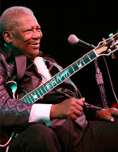
- He’s the king of the blues, the genre’s elder statesman, and a one-of-a-kind musician. B.B. King is that one guitarist who nearly anyone can recognize with only a single note. Of course, that note would sing with sustain and be drenched in fret-hand vibrato. Nobody plays, or sings, the blues like King. He was, and still is, at the forefront of electric blues guitar. His catalog is essential listening for anyone even thinking of playing a 12-bar tune. Indeed, noteworthy players such as Eric Clapton, Mike Bloomfield, Buddy Guy, and Jimi Hendrix all cut their teeth on King’s solos. And now, eighty years young and still out on the road, King is a living legend if there ever was one. Let’s explore the licks and phrases of this blues giant.
B.B.’s Boxes
An analysis of King’s soloing style reveals that he often plays in small box patterns that rarely reach beyond an octave and a half. His favorite boxes are pictured in Figs 1A–C. All in the key of G, they represent three different areas of the fretboard. The circled dots are the roots (G); the standard dots are the primary, or anchor tones; and the Xs are additional color tones. Notice that the primary boxes (the five anchor tones) are identical in shape.
The anchor tones in the first box (Fig. 1A) make up the notes of the G major pentatonic scale (G–A–B–D–E), while the color tones add the b3rd (Bb), 4th (C), and b7th (F). Box 2 (often called the “Albert King” box) is essentially the G minor pentatonic scale (G–Bb–C–D–F) with a major 3rd (B) color tone. Box 3 (commonly known as the “B.B. King” box) is an ambiguous batch of notes (G–A–C–D–E) that, when isolated, are neither major nor minor in tonality. But, combined with the color tones (b3rd [Bb], major 3rd [B], and b5th [Db]), this box provides a boatload of tonal possibilities.
The King’s Licks
Now that we’re equipped with our B.B. boxes, let’s use them to target some of the king’s licks. Fig. 2 sets Box 1 in play over a V–IV–I (D7–C7–G7) cadence in the key of G. Chord-tone conscious through and through, the first measure brings out the 13th (A) and the 9th (E) of the D7 chord (take that whole-step bend with your 3rd finger), while the second measure uses color tones, just outside of the box, to nail the b7th (Bb) of the C7 chord. When the I chord (G7) arrives, all notes come into play, starting with a minor 3rd/major 3rd handoff (quick hammer-on from Bb to B, a fixture of King’s style), and a b7th/major 6th (F and E) interplay in beats 2 and 3. The example goes out with a King-style arpeggiated sweep down the lower strings.
Fig. 3 moves from Box 1 to Box 2. It begins with King’s famous “slide to the 1” lick, in which he plays the tonic on the 1st string, then echoes it with a quick slide up to the same pitch on the 2nd string. Once there, he wiggles the note like crazy, to achieve his trademark hummingbird-like vibrato. Some people work a lifetime trying to master this wicked technique. Here’s some general advice to help you on your way: While fretting the note, drop your palm from the back of the neck and literally shake your whole hand, flicking your wrist in a rapid, circular motion. The second half of the example features some crafty, half-step bends that culminate in a trio of chromatic passages (Bb–B–C).
Fig. 4 highlights Box 3 in an example that isolates the turnaround (last four bars) of a 12-bar blues in G. The first phrase features a chromatic descent from the root (D) to the b7th (C) of the V chord (D7). Next comes an instantly recognizable King lick involving a half-step bend to the b7th (Bb) of the IV chord (C7). (King often uses this same batch of notes over the I chord.) Some notes slip out of the box in measures 3 and 4, but are nonetheless very characteristic of King’s style, especially the quick, descending rake (adjacent strings are struck using the same picking direction) on the downbeat of measure 4.
Fig. 5 reflects King’s economic phrasing in a slow, minor-key blues setting similar to “The Thrill Is Gone.” Firmly planted in Box 2 of the B minor pentatonic scale (B–D–E–F#–A), the bends and color notes supply an additional b5th (F) and major 3rd (D#). Those 1st-finger, whole-step bends on the high-E string aren’t for the faint of heart. Drop the “pinky side” of your hand toward the floor, press the underside of your knuckle hard up against the back of the neck, and use your thumb for added leverage to push the string up to pitch. Ouch. Sometimes it hurts to play the blues.
The Solo
Like many of King’s, the form of the solo [Fig. 6] is a 12-bar, dominant-chord blues shuffle at a moderate tempo (84 bpm). It involves a quick-change measure, in which the IV chord (C7) first arrives in the second bar, as opposed to the fifth measure. The I–IV–V (G7–C7–D7) 12-bar progression is played twice, ending on a chromatic cadence (G7–C7–C#º7–D7–Ab7–G7) in the final measures. (Tone tip: Use the middle setting of a twin-humbucker guitar, and a tube combo amp, with the tone controls set flat and the volume set just to the breakup point.)
The opening phrase, which rides the top portion of Box 1 and includes a whole-step bend, is similar to the one B.B. plays in “You Done Lost Your Good Thing Now,” from My Kind of Blues. (This 1960 album is a personal favorite of King.) The answer phrase, which greets the IV chord, begins with a pre-bend—bend the note to pitch before striking it—and culminates in King’s “slide to the 1” lick, enhanced with stinging vibrato. Half-step bends in measure 3 provide major/minor 3rd interplay over the I chord (G7). Make sure you’re bending true to pitch here. The fourth measure contains a signature G major arpeggio (G–B–D) wrap-up phrase, led off by a b3rd (Bb) grace-note hammer-on.
The slightly bizarre bends in measure 5 forecast the aggressive stylings of Jimi Hendrix and Stevie Ray Vaughan. You’ll hear King pull out these types of licks in early recordings such as 1953’s hit single “Please Love Me.” At the end of measure 6 we scoot up to the B.B. King box (via a short stopover in the Albert King box on beat 2) for a trio of characteristic phrases. The first one involves a slow bend to the 3rd (B) of the I chord; the other two center on matching chromatic passages on the 1st string. Don’t forget to end your phrases with the hummingbird vibrato discussed in Fig. 3.
Measure 9 borrows the I chord lick discussed in Fig. 3, and drops it into the V chord slot (D7). As notated, play the half-step bends in eighth-note triplets. Measures 11–12 feature a rhythmically intense turnaround phrase, typical of the ones King plays in slow blues settings. You’ll hear Eric Clapton performing variations on this phrase throughout Cream’s “Crossroads.”
The second half of the solo opens in bar 13 with an extended version of the “hanging on the 1” phrase from the solo in 1954’s “You Upset Me Baby.” Remember, this line will fall dead without King-style vibrato. A definitively happy King phrase, courtesy of a major 3rd/perfect 4th interplay, marks measure 15. King plays a similar phrase in “Cryin’ Won’t Help You.” This is followed by a formidable 1 1/2-step bend. Use your 3rd finger, reinforced by your 2nd and 1st fingers, to push the string to pitch.
The straight-eighth repetition lick in measure 17 recalls a memorable moment from “The Thrill Is Gone,” where King hammers home the tonic note high up on the neck. Be sure to get the muted 2nd string in there for added impact. Fret the high G note with your 3rd finger, and mute the B string at the 13th fret with your 1st finger. Measure 19 dives back down to Box 1 for a three-measure passage comprised of a variety of bends, stinging vibrato, and arpeggio rakes. Measures 21–22 comprise the chord-tone nailing tactics discussed in Fig. 2, and the solo goes out with a chromatically enhanced turnaround lick and one of King’s favorite chords—yes, contrary to popular belief, he can play chords!—a dominant-7th partial on strings 5–3.
Get The Pick Newsletter
All the latest guitar news, interviews, lessons, reviews, deals and more, direct to your inbox!
A Musicians Institute teacher since 1989, Tom Kolb has published many books on guitar technique and been featured in instructional DVDs by Hal Leonard. He is also the author of the Soloing Strategies column in Guitar World magazine.
“There are so many sounds to be discovered when you get away from using a pick”: Jared James Nichols shows you how to add “snap, crackle and pop” to your playing with banjo rolls and string snaps
Don't let chord inversions bamboozle you. It's simply the case of shuffling the notes around








![Joe Bonamassa [left] wears a deep blue suit and polka-dotted shirt and plays his green refin Strat; the late Irish blues legend Rory Gallagher [right] screams and inflicts some punishment on his heavily worn number one Stratocaster.](https://cdn.mos.cms.futurecdn.net/cw28h7UBcTVfTLs7p7eiLe.jpg)


